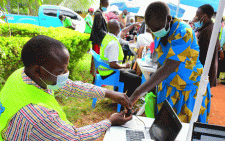In the heart of Kenya’s pastoralist communities, where cattle are the lifeline of survival, Dr Wyckliff Ngetich, a veterinary surgeon and PhD fellow at the Feed the Future Innovation Lab for Animal Health (AHIL), is spearheading efforts to combat East Coast Fever (ECF), a devastating tick-borne disease.
The disease threatens the economic stability of rural households and exacerbates food insecurity and malnutrition.
Dr Ngetich has been at the forefront of uncovering East Coast Fever, ECF, prevalence, creating disease awareness, and spreading the word on preventive and treatment measures in Narok County.
Despite the documented prevalence of ECF in the region, most farmers that Dr. Ngetich and his team have engaged with claim to have become aware of the disease, its prevention, and treatment through the AHIL project. This background alone stamps the relevance of the AHIL program.
The scale of the ECF burden is significant, but it’s not insurmountable. Dr. Ngetich, a lecturer at Egerton University, believes we can alleviate this challenge with urgent and concerted efforts. He is proud to be part of a team that makes a difference.
Farming communities
ECF, a cattle disease informally known as ‘cattle malaria,’ is extensively spreading in farming communities. Farmers are struggling to keep their animals alive and, therefore, to feed themselves and their families.
ECF is a tick-transmitted disease caused by the protozoan parasite Theileria parva.
It kills cattle within three weeks of infection through a fluid build-up in their lungs, otherwise called pulmonary edema, drowning the animals, explained Feed The Future Innovation Lab for Animal Health Program Manager Dr. Mulei Muema.
The disease kills one cow every 30 seconds, and over 50 million cattle in central, eastern, and southern Africa are at risk of it.
Because the deadly cattle disease indirectly affects the health and nutrition of families, specifically mothers and their children, global researchers are tackling the disease and its side effects on farmers’ livelihoods.
“We have evidence that the disease is present in Narok South, and we went deeper and found out that almost 30 percent of the cattle population is at risk of getting the disease within their first year of life,” said Dr Ngetich, referring to the AHIL study, which has enrolled 600 households in the expansive Narok South sub-county.
AHIL is being implemented in 600 households in Narok County, Kenya, to improve human nutrition, economic welfare, and resilience by removing cattle health and production constraints in Kenya and the East Africa region.
According to Dr Ng’etich, East Coast Fever is one of the biggest killers of cattle in sub-Saharan Africa, with various studies estimating that over one million cows die annually from the deadly tick-borne disease.
Heightened malnutrition
Such loss of livestock, especially for pastoralist communities, has devastating effects, including loss of livelihoods, food insecurity, and a heightened malnutrition risk, particularly among children.
Therefore, finding lasting solutions to stem the disease and curb its threats to communities is essential and urgent. This journey begins with identifying hotspots and understanding the extent of the spread.
Dr Ng’etich is part of the AHIL team studying the disease in Narok South, home to one of the main pastoralist communities in Kenya and, according to preliminary studies, an ECF hotspot.
Further, Dr Ngetich and his team have established a 44.4 percent mortality rate for infected animals, which he notes is very high for indigenous breeds, which are generally more resilient than exotic ones.
According to Ngetich, the mortality rate of exotic cattle breeds affected by the disease can be as high as 80 percent.
ECF is estimated to affect over 20 million smallholder livestock farmers in 12 countries across Africa, including Kenya, and causes over $300 million in economic losses yearly. The mortality rate and losses could be higher as reporting is low for isolated livestock farmers.
Dr. Ngetich firmly believes these communities can be reached, but county governments must invest significantly in effective agricultural extension services.
He says extension services can also help raise awareness of the spread of disease and available preventive measures.
“Because of the awareness we are creating, livestock farmers under this project have gotten to know about the vaccine and are eagerly asking when they will finally access them,” said Dr.Ngetich.





















